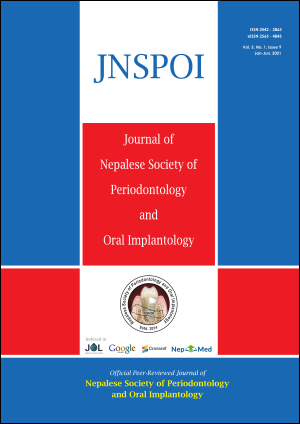Assessment of Labial Alveolar Bone Thickness in Maxillary Central Incisor using Cone Beam Computed Tomography
DOI:
https://doi.org/10.3126/jnspoi.v5i1.38175Keywords:
Aesthetic, implant, labial boneAbstract
Introduction: The maxillary anterior region is becoming a major concern due to its aesthetic relevance. The buccal bone thickness is important for implant placement, orthodontic treatment and restorative treatment.
Objective: To assess the thickness of alveolar bone in the maxillary central incisor using cone beam computed tomography (CBCT).
Methods: A cross-sectional observational study was conducted at Department of Dental Surgery, Bir Hospital where CBCT of 53 samples from July 2019 till December 2019, the archived CBCT images was assessed retrospectively. The thickness of the labial bone in a direction perpendicular to the outer surface of the tooth root was measured at a distance of 2 mm from the cementoenamel junction (CEJ). The measurement was taken thrice and the mean measurement was considered.
Results: The labial alveolar bone thickness in maxillary central incisor was found to be 0.55±0.27 mm at a distance of 2 mm from the CEJ. Only 2 (3.8%) of the samples had an alveolar thickness of >1 mm. No statistically significant difference was found with respect to gender and age.
Conclusion: The average thickness of the labial alveolar bone in maxillary central incisor using cone beam computed tomography was found to be thin.
Downloads
Downloads
Published
How to Cite
Issue
Section
License
© Nepalese Society of Periodontology and Oral implantology (NSPOI)
Licenced by Creative Commons Attribution 4.0 International License.




